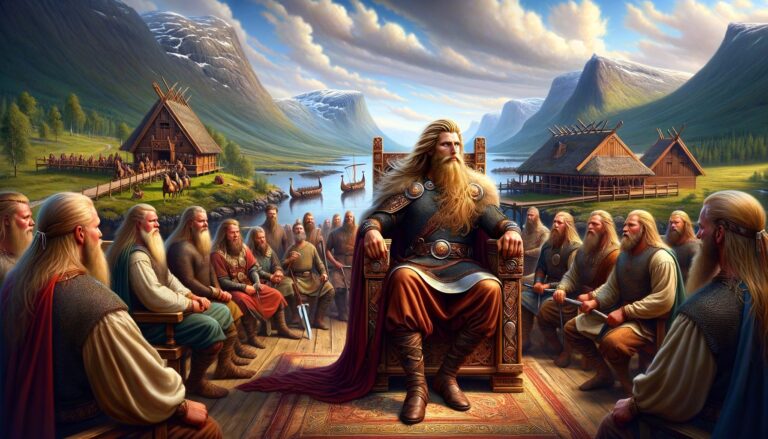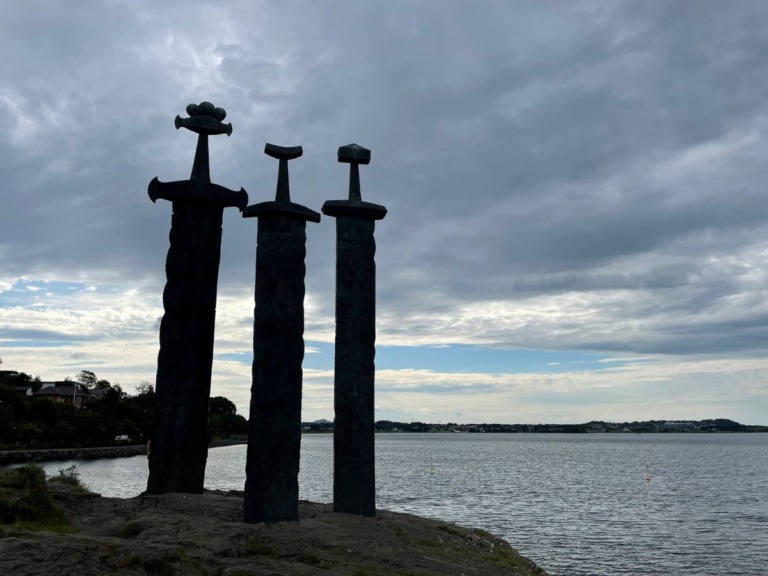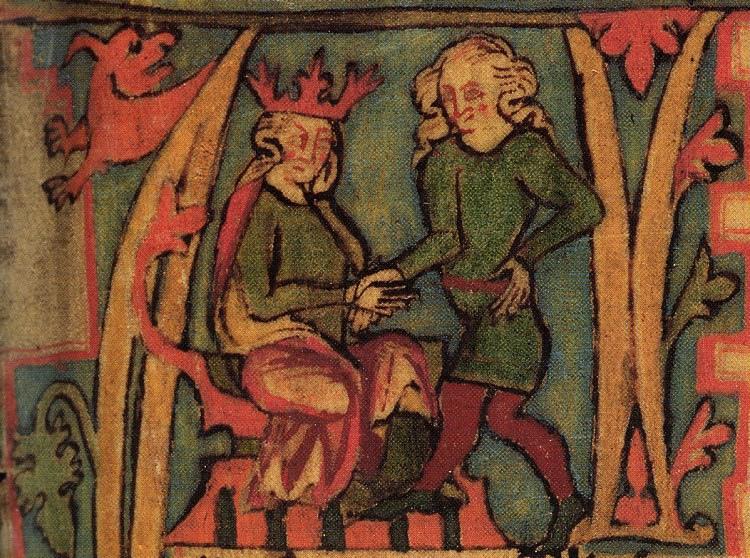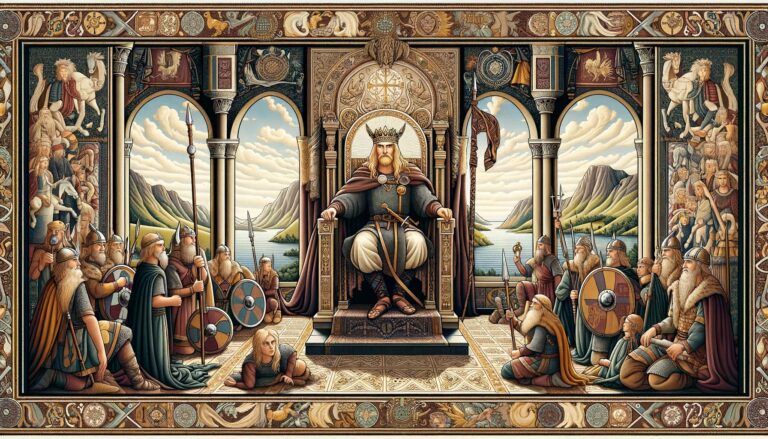If you ever looked up Norwegian history, chances are you came across the name of Harald Fairhair, the first king of Norway. His story is like a mix of legend and real-life Viking drama.
In a time when Norway was a collection of smaller territories, each with its own ruler, Harald had an ambition to unite them all. Some say he actually did it for love.

But first a disclaimer: As usual with Viking history, it’s pretty hard to parse out fact from fantasy and “facts” have to be interpreted with a generous pinch of salt. Anyone claiming to give you the whole, unquestionable truth about Harald Fairhair is either lying or misinformed.
With that out of the way, let’s dust off the old sagas, check the archeological evidence and delve into the story of this famous Viking Age figure. Who knows, maybe we’ll even find out how he got his nickname.
Harald Fairhair fought his decisive battle in 872
The famous battle credited for the unification of Norway was fought in Hafrsfjord, part of today’s Stavanger, in or around 872.
The sagas tell us that Harald, after inheriting Vestfold and the Opplands from his father, allied himself with the Earl of Hålogaland (that’s what they called Northern Norway back then).
Then, Harald is said to have gained influence in Trøndelag before he attacked the sea kings in Southwest Norway. He won the battle and Norway was unified – the end.
But that simple story is not necessarily what happened. Some poems recounting the events have the basic setup of the battle the other way around: they say it was Harald who was attacked by kings coming from the East.
Either way, the reason for the battle was likely not the idea of unifying Norway but the control of the trade route between Western Norway and Kaupang, a Viking settlement near today’s Larvik. Controlling this trade route thanks to a foothold in Hafrsfjord would have meant lots of income for Harald.

Today, the battle is commemorated by a very cool monument called “Sverd i fjell” (Swords in Rock). You can see it just west of the city of Stavanger, in a nice little park by the water.
Harald Fairhair’s name is even cooler than you think
As nicknames go, “Fairhair” is not bad at all. But it’s probably even better than you think.
“Fairhair” is a translation of the Norwegian “Hårfagre”, which itself comes from the Old Norse “hárfagri”. “Fair” in English can mean many different things, but in this context it means “pleasing to the eye”.
The Norwegian word “fager”, though, means something more like “really, very beautiful indeed”. So to be called Hårfagre is an even nicer thing than to be called Fairhair.
Harald Fairhair got his nickname because of love – or not
Okay so we don’t really know why he was called Fairhair. A lot of what we know from that time came through oral history which was then written down, sometimes centuries later, and copied over and over.
Some historians think the “hárfagri” nickname might have been a misreading, and its backstory just invented after the fact to explain it. But if we are to believe the tradition, Harald was really into a woman called Gyda Eiriksdatter.

This Gyda girl had high standards, it seems, because she declared that she wouldn’t have him until he had united Norway into one kingdom. Harald, obviously under the spell, agreed and vowed to not cut his hair until he had united Norway into one kingdom – and that’s why he was called Fairhair.
It’s a nice story to tell and repeat, but you don’t really have to try very hard to poke holes through it. I mean just because you stop cutting your hair doesn’t make it beautiful – especially in shampooless mediaeval times.
Most likely, Harald wanted to capitalise on the collection of small kingdoms in the Opplands he had inherited from his father, and on the fact that the Danes were weakened at the time. Of course it's possible that Gyda overheard Harald's plans and then said she wouldn't marry him until he had completed his mission.
Harald Fairhair beat Gandalf
You read that right! Harald Fairhair defeated Gandalf in battle.
We’re not talking about Tolkien’s wizard, of course, but it’s a pretty cool story regardless. Harald Fairhair became king at the age of twelve when his father, Halfdan the Black (Halvdan Svarte) died.
Halfdan was powerful but had enemies. One of them was a king ruling over a place called Vingulmark (essentially the Oslo fjord area).
This king’s name was Gandalf (Gandalv, in Norwegian). Halfdan defeated Gandalv, but then went on to die after falling through the ice on the Randsfjorden after a night of heavy drinking.

That gave Gandalf the opportunity to strike again. Luckily, Harald Fairhair received help from Halfdan's brother Gudtorm, and from a handful of berserkers (fearsome warriors wearing bear skins) and managed to defeat him.
Harald Fairhair: We don’t know for sure that he actually existed
We warned you at the beginning of this article: sources about Norwegian history in Viking times are pretty fuzzy. Harald Fairhair’s name is mentioned in many sagas, but these sagas don’t agree with each other on the details, and more importantly, they were written more than 200 years after the fact.
Through the 1800s and most of the 1900s, his existence as a historical character was accepted as a fact. That all changed when British historian Peter Sawyer started casting doubt on this accepted version of history.
That the sagas are inconsistent is one thing, but an even bigger problem is that there is not a single source from Harald Fairhair’s time telling us about him.
A view commonly held by historians today is that Harald may have been based on a real king named Harald, but that a lot of the details about him are either invented or a mashup of things that happened to different people.
In that sense, Harald Fairhair is a bit like England’s King Arthur – a mythical figure which may or may not have been based on a real person. Most likely, the myth of Harald Fairhair was concocted in the 1100s, to give legitimacy to the kings of the time who claimed their lineage went back all the way to this “first king of Norway”.
Harald Fairhair is said to have been buried near Haugesund
Now that we told you he might not even have existed, let’s tell you about his grave. The most likely date for his death is thought to be the year 932. As was the custom at the time, he would have been interred in a burial mound.
This happened (or not) just north of today’s Haugesund. In 1872, one thousand years after Fairhair’s reported unification of Norway, a fundraiser was launched to celebrate the anniversary by erecting a monument.
The fundraiser didn’t gather enough money, and Stortinget (the Norwegian parliament) had to pay the balance. But the monument to the kingdom’s “thousand year existence” can still be viewed there today.


I am of Norwegian Heritage. I am Australian. My father went to Australia in 1952 after “jumping ship” in Sydney.
He was told as a little boy he was related to the “First King of Norway” so he is of Viking blood. I wish there was a way to go right back through and actually find out if Harald and his stories were true. I love Viking stories